Image Caption: Curiosity at work on Mars inside Gale Crater. Panoramic mosaic showing Curiosity in action with her wheel tracks and the surrounding terrain snapped from the location the rover drove to on Sol 29 (Sept 4). The time lapse imagery highlights post drive wheel tracks at left, movement of the robotic arm from the stowed to deployed position with pointing instrument turret at right with Mt Sharp and a self portrait of Curiosity’s instrument packed deck top at center. This colorized mosaic was assembled from navigation camera (Navcam) images taken over multiple Martian days while stationary beginning on Sol 29. Click to Enlarge. Credit: NASA/JPL-Caltech/Ken Kremer/Marco Di Lorenzo
NASA’s Mega Martian Rover Curiosity is swiftly trekking across the Red Planet’s science rich terrain inside Gale Crater as she approaches the two month anniversary since the daring atmospheric plunge and pinpoint touchdown on Aug. 5/6 beside her eventual destination of the richly layered mountainside of Mount Sharp.
In this ultra short span of time, Curiosity has already fulfilled on her stated goal of seeking the signs of life and potentially habitable environments by discovering evidence for an ancient Martian stream bed at three different locations – at the landing site and stops along her traverse route – where hip deep liquid water once vigorously flowed billions of years ago. [click to continue…]
After a three-day delay, the European Space Agency’s “Edoardo Amaldi” Automated Transfer Vehicle (ATV-3) undocked from the aft port of the International Space Station’s Zvezda service module at 21:44 UTC (5:44 p.m. EDT) on Friday.
Tuesday’s initial attempt to undock the European cargo ship was called off due to a communications error between the Zvezda module’s proximity communications equipment and computers on the ATV. Russian flight controllers resolved the problem, but then an additional delay occurred because of the possibility of two pieces of space debris coming close to the ISS, and the ATV would have been used to perform an avoidance maneuver; however, it was later deemed the debris posed no threat.
Now you see it, now you don’t! Around the solstices, the Solar Dynamics Observatory ends up having an “eclipse season,” where the Sun, Earth, and the SDO line up, and some of the images and video sent down from the spacecraft appear as though the Sun disappears for a while or just part of the Sun is visible. This is a normal part of life with a geosynchronous observatory, the SDO team says.
They explain it this way:
[click to continue…]
[click to continue…]
Why is everyone so excited about these dusty Mars rocks?
This week’s big news was the announcement of evidence for flowing water on Mars, based on images of what appear to be smooth river rock-type pebbles found by Curiosity. Of course that’s a big statement to make, and for good reason — identifying water, whether present or past, is one step closer to determining whether Mars was ever a suitable place for life to develop. Yet here we are, not even two months into the mission and Curiosity is already sending us solid clues that Mars was once a much wetter place than it is now.
JPL released a video today providing a brief-but-informative overview of what Curiosity has discovered in Gale Crater and why it’s gotten everyone so excited.
Check it out so you’ll have something to talk about over the weekend: [click to continue…]
This was an action-packed episode of the Weekly Space Hangout. Lots of stories, very little time.
- Super Comet or Super Dud?
- Crescent Moon in the Martian Sky
- Supersonic Skydive
- Hubble eXtreme Deep Field
- SpaceX Grasshopper
- Base Beyond the Moon
- Titan Paddleboat Mission
- Mars Sample Return Mission
- Milky Way’s Hot Halo
Host: Fraser Cain
Want to watch us record the show live? Point your browser at next week’s event page to put the recording right into your calendar.
NGC6888 The Crescent Nebula & Wolf Rayet Star (WR136). Credit: John Chumack.
Here’s an impressive shot of NGC 6888, also known as the Crescent Nebula, which is a cosmic bubble about 25 light-years across. It is part of the massive Gamma Cygni Nebula region, and in the center is a powerful, bright and massive Wolf-Rayet star. “The very energetic Wolf-Rayet star is shedding its outer envelope in a strong stellar wind, ejecting the equivalent of the Sun’s mass every 10,000 years,” explains prolific and talented astrophotographer John Chumack. “This cosmic bubble is located in this very rich star studded field, which is about 3,000 light years away.”
To capture this image, John used a QHY8 cooled Color CCD Camera and his homemade 16″ Newtonian Scope, with a 90 minute exposure, taken on August 24, 2012 at his observatory in Yellow Springs, Ohio. See more of his work at his website, Galactic Images.
Want to get your astrophoto featured on Universe Today? Join our Flickr group or send us your images by email (this means you’re giving us permission to post them). Please explain what’s in the picture, when you took it, the equipment you used, etc.
Combined images taken simultaneously (06 June 2012, 03:46:18 UTC) from Svalbard and Canberra, showing the Venus parallax effect from 2 different locations on Earth, separated by 11600km. Credit: Pérez Ayúcar/Breitfellner
Back in the 18th century, astronomers were trying to determine the distance from the Earth to the Sun. They used the parallax method during the Transits of Venus the 1760s to help answer that question, and their results provided a cosmic measuring stick that has allowed astronomers to measure distances in the Universe.
How did that method work? New images and movies of the transit of Venus on June 6, 2012 which compare event from two different locations on Earth clearly show the parallax effects that have made Venus transits so important historically.
[click to continue…]
[click to continue…]
Dawn image of Vesta showing its nearly circumferential equatorial grooves (NASA/JPL-Caltech/UCLA/MPS/DLR/IDA)
Even though NASA’s Dawn spacecraft has departed Vesta the trove of data it’s gathered about this fascinating little world continues to fuel new discoveries. Most recently, some researchers are suggesting that Vesta’s curious grooves — long, deep troughs that wrap around its equator, noticed immediately after Dawn came within close proximity — are actually features called graben, the results of surface expansion along fault lines.
In Vesta’s case, the faults likely may have come from whatever major collision created the enormous central peak that rises almost three times the height of Mt. Everest from its south pole… and the expansion could be the result of differentiation of its interior — a separation of core, mantle and crust that’s much more planet-like than anything asteroidish.
NASA’s Curiosity rover found evidence for an ancient, flowing stream on Mars at a few sites, including the rock outcrop pictured here, which the science team has named “Hottah” after Hottah Lake in Canada’s Northwest Territories. Credit: NASA/JPL/Caltech
The Curiosity rover has come across a place in Gale Crater where ankle-to-hip-deep water once vigorously flowed: an ancient streambed containing evidence of gravel that has been worn by water. At a press briefing today, members of the Mars Science Laboratory team said the rover has found “surprising” outcrops and gravel near the rover landing site that indicate water once flowed in this region, and likely flowed for a long time.
“Too many things that point away from a single burst event,” said Curiosity science co-investigator William Dietrich of the University of California, Berkeley. “I’m comfortable to argue that it is beyond the 1,000 year timescales, even though this is very early on in our findings.”
[click to continue…]
[click to continue…]
The original observations (top) and interpretations (bottom) of the first ever amateur albedo map of Ganymede. Credit: Manos Kardasis.
As our frequent “Astrophoto” posts from amateur astronomers and photographers attest – as well as the rise of citizen science — , the latest technology allows amatuers to make significant contributions to the field of astronomy. Case in point: Emmanuel I. Kardasis of the Hellenic Amateur Astronomy Association has produced the first amateur albedo map of Jupiter’s moon Ganymede. He used an off-the-shelf telescope, camera and computer equipment, but put his experienced observing skills to the test.
“Ganymede has a tiny disk as seen from Earth so was a good test for my techniques,” said Kardasis. “If the same methods were applied to other worlds, perhaps the volcanic moon Io, we could capture surface fluctuations. Professional observatories may create better images but they cannot monitor our rapidly and ever-changing Universe.”
[click to continue…]
[click to continue…]
Read more: http://www.universetoday.com/#ixzz27yoGv2Hp

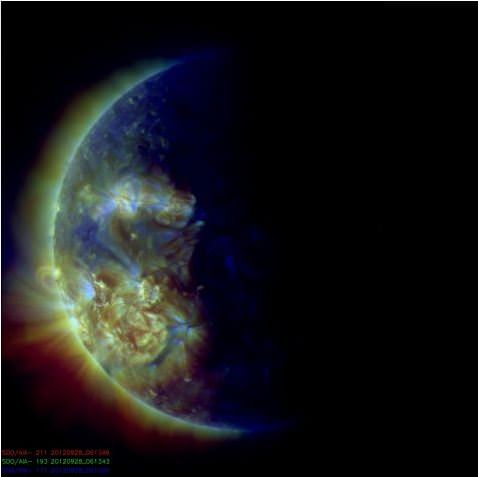
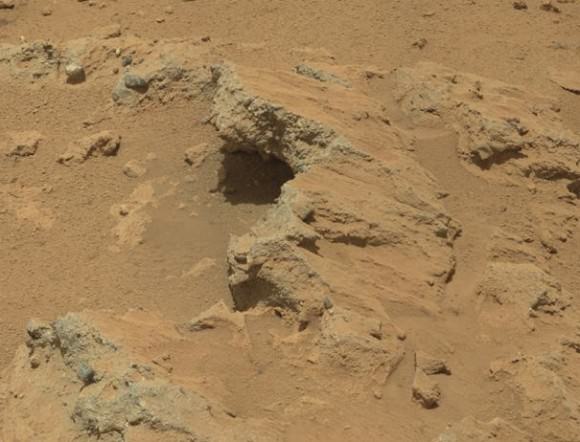

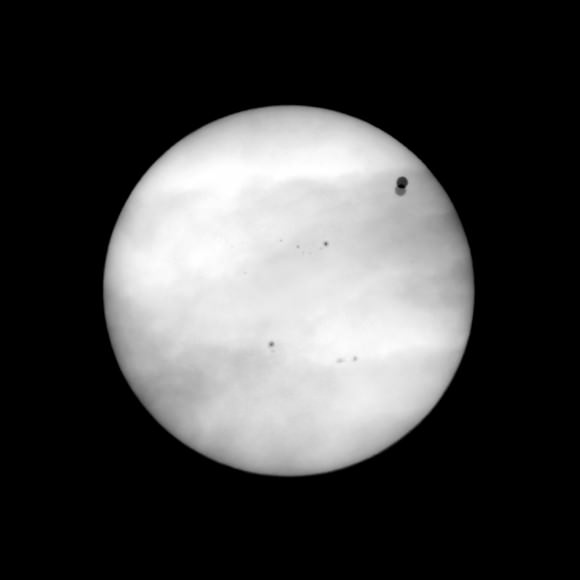

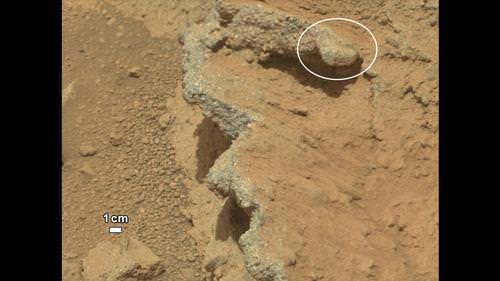
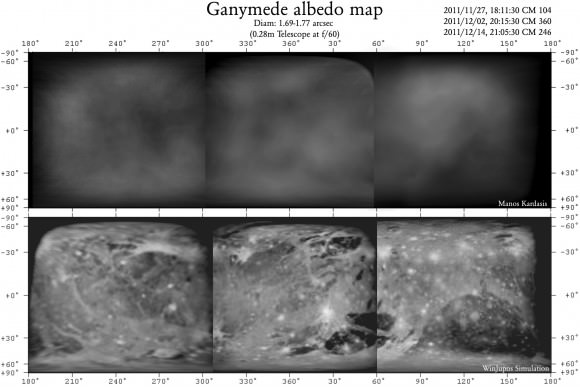
No comments:
Post a Comment